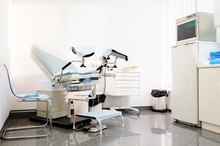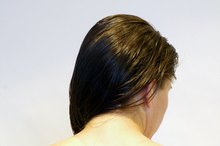What Is the Difference Between a Regular Mammogram & a Bilateral Mammogram?
Mammography is currently the most effective procedure to detect and diagnose diseases of the breast 2. A “regular” mammogram is generally considered to be a “screening” mammogram for asymptomatic women and is usually ordered as “bilateral,” meaning both breasts are screened.
Mammography
Until recently, mammograms were administered via low-dose x-rays and the image transferred to film for review. Most mammograms today utilize full-field digital mammography (FFDM), commonly referred to as digital mammography 2. This modality works similar to a digital camera, where the images can be viewed on a computer screen and/or transferred to film. The imaging is greatly enhanced with the digital method and thus preferred. Both techniques utilize low-dose x-rays and are administered in the same manner to capture breast images.
- Until recently, mammograms were administered via low-dose x-rays and the image transferred to film for review.
Baseline Mammogram
What Are the Causes of Incomplete Mammogram Results?
Learn More
It is generally recommended that asymptomatic women between the ages of 35 to 39 obtain a baseline mammogram. A baseline is established and compared to future mammograms to detect any changes in the breasts.
Screening Mammogram
A screening mammogram is performed to detect any breast cancer as early as possible for the best possible prognosis. The American Cancer Society (ACS), the American Medical Association (AMA) and the American College of Radiology (ACR) recommend yearly screening mammograms beginning at the age of 40 and annually thereafter.
Diagnostic Mammogram
5 Things You Need to Know About Breast Cancer Symptoms
Learn More
If a woman has symptoms of breast cancer (lumps, nipple discharge, dimpling, etc.) a diagnostic mammogram is conducted to further study and diagnose any abnormalities in the breast.
Bilateral Mammogram
Bilateral refers to the right and left sides, or members, of a paired organ in the body. Most mammograms are ordered as bilateral, the exception being when one breast exhibits abnormalities and additional mammography views are needed 2.
Breast Cancer in Men
Men can also develop breast cancer, but it is very rare (less than 1 percent of all new breast cancers). However, any suspicious symptoms call for further evaluation.
Related Articles
References
- BreastCancer.org: Symptoms & Diagnosis
- RadiologyInfo: Mammography
- Løberg M, Lousdal ML, Bretthauer M, Kalager M. Benefits and harms of mammography screening. Breast Cancer Res. 2015;17(1):63. Published 2015 May 1. doi:10.1186/s13058-015-0525-z
- Centers For Disease Control and Prevention. Breast Cancer Screening Guidelines for Women. Breast Cancer. Published November 5, 2018.
- Koo MM, von Wagner C, Abel GA, McPhail S, Rubin GP, Lyratzopoulos G. Typical and atypical presenting symptoms of breast cancer and their associations with diagnostic intervals: Evidence from a national audit of cancer diagnosis. Cancer Epidemiol. 2017;48:140–146. doi:10.1016/j.canep.2017.04.010
- Yalaza M, İnan A, Bozer M. Male Breast Cancer. J Breast Health. 2016;12(1):1–8. Published 2016 Jan 1. doi:10.5152/tjbh.2015.2711
- Sinclair N, Littenberg B, Geller B, Muss H. Accuracy of Screening Mammography in Older Women. American Journal of Roentgenology. 2011;197(5):1268-1273. doi:10.2214/ajr.10.5442
- Jain M, Jain A, Hyzy MD, Werth G. FAST MRI breast screening revisited. Journal of Medical Imaging and Radiation Oncology. 2016;61(1):24-28. doi:10.1111/1754-9485.12502
- Amano G. MRI Accurately Depicts Underlying DCIS in a Patient with Pagets Disease of the Breast Without Palpable Mass and Mammography Findings. Japanese Journal of Clinical Oncology. 2005;35(3):149-153. doi:10.1093/jjco/hyi044
- Yeh ED, Jacene HA, Bellon JR. What Radiologists Need to Know about Diagnosis and Treatment of Inflammatory Breast Cancer: A Multidisciplinary Approach. RadioGraphics. 2013;33(7):2003-2017. doi:10.1148/rg.337135503
- Horsley RK, Kling JM, Vegunta S, Lorans R, Temkit HH, Patel BK. Baseline Mammography: What Is It and Why Is It Important? A Cross-Sectional Survey of Women Undergoing Screening Mammography. Journal of the American College of Radiology. 2019;16(2):164-169. doi:10.1016/j.jacr.2018.07.002
- Juanpere S, Perez E, Huc O, Motos N, Pont J, Pedraza S. Imaging of breast implants—a pictorial review. Insights into Imaging. 2011;2(6):653-670. doi:10.1007/s13244-011-0122-3
- Akram M, Iqbal M, Daniyal M, Khan AU. Awareness and current knowledge of breast cancer. Biol Res. 2017;50(1):33. Published 2017 Oct 2. doi:10.1186/s40659-017-0140-9
- Vreugdenburg TD, Willis CD, Mundy L, Hiller JE. A systematic review of elastography, electrical impedance scanning, and digital infrared thermography for breast cancer screening and diagnosis. Breast Cancer Research and Treatment. 2013;137(3):665-676. doi:10.1007/s10549-012-2393-x
- Lee CI, Chen LE, Elmore JG. Risk-based Breast Cancer Screening: Implications of Breast Density. Med Clin North Am. 2017;101(4):725–741. doi:10.1016/j.mcna.2017.03.005
- Miglioretti DL, Lange J, van den Broek JJ. Radiation-Induced Breast Cancer Incidence and Mortality From Digital Mammography Screening: A Modeling Study. Ann Intern Med. 2016;164(4):205–214. doi:10.7326/M15-1241
- Rose MG. Oncology in Primary Care. Wolters Kluwer Health: Lippincott Williams & Wilkins; 2013.
- Lee NC, Wong FL, Jamison PM. Implementation of the National Breast and Cervical Cancer Early Detection Program: the beginning. Cancer. 2014;120 Suppl 16(0 16):2540–2548. doi:10.1002/cncr.28820
- de Groot JE, Broeders MJ, Grimbergen CA, den Heeten GJ. Pain-preventing strategies in mammography: an observational study of simultaneously recorded pain and breast mechanics throughout the entire breast compression cycle. BMC Womens Health. 2015;15:26. doi:10.1186/s12905-015-0185-2
- Sharp PC, Michielutte R, Freimanis R, Cunningham L, Spangler J, Burnette V. Reported Pain Following Mammography Screening. Archives of Internal Medicine. 2003;163(7):833. doi:10.1001/archinte.163.7.833
- Karliner LS, Patricia Kaplan C, Juarbe T, Pasick R, Pérez-Stable EJ. Poor patient comprehension of abnormal mammography results. J Gen Intern Med. 2005;20(5):432–437. doi:10.1111/j.1525-1497.2005.40281.x
- Rao AA, Feneis J, Lalonde C, Ojeda-Fournier H. A Pictorial Review of Changes in the BI-RADS Fifth Edition. RadioGraphics. 2016;36(3):623-639. doi:10.1148/rg.2016150178
- Seely JM, Alhassan T. Screening for breast cancer in 2018-what should we be doing today?. Curr Oncol. 2018;25(Suppl 1):S115–S124. doi:10.3747/co.25.3770
- American Cancer Society. Limitations of Mammograms. Atlanta, Georgia; updated 10/09/17.
- Harris, J., Lippman M., Morrow, M., Osborne, C., eds. (2014) Diseases of the Breast. 5th ed. Philadelphia, PA: Lippincott, Williams & Wilkins.
- Miglioretti, D., Lange, J., van den Broek, J. et al. Radiation-Induced Breast Cancer Incidence and Mortality from Digital Mammography Screening. Ann Int Med. 2016. 164(4):205-14. DOI: 10.7326/m15-1241.
- U.S. Food and Drug Administration. Breast Cancer Screening: Thermogram No Substitute for Mammogram. Silver Spring, Maryland; updated 10/27/17.
Writer Bio
Susan Malley is an innovative professional with more than 15 years of experience in developing and writing documents for corporate communications. In 2007, Malley transitioned into a freelance writing career. She began writing marketing materials for a major hospital and published an essay for Women's Lifestyle Magazine.






